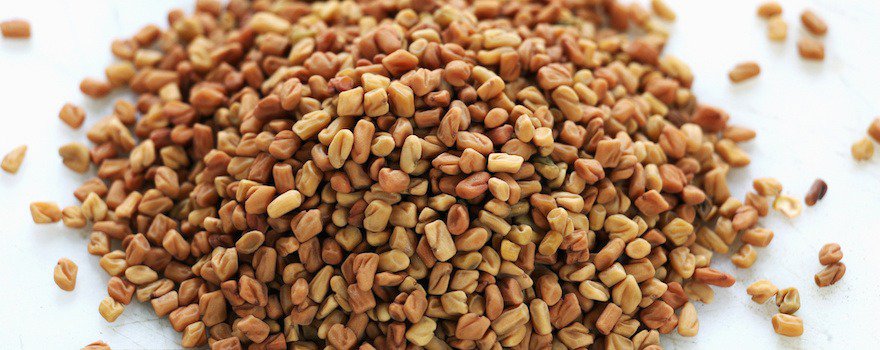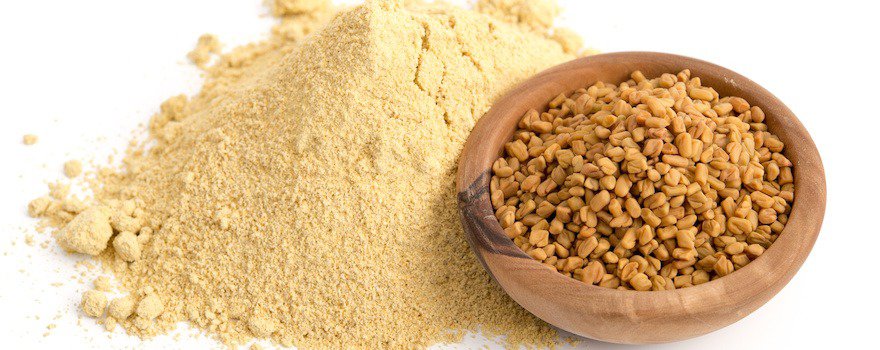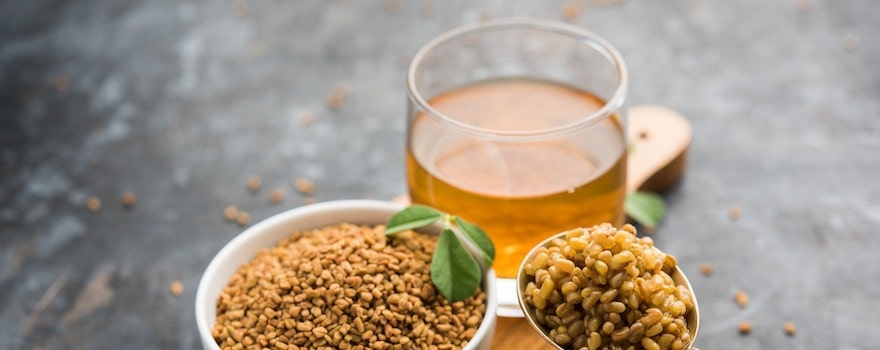BENEFITS OF FENUGREEK
✓ Antidiabetic
✓ Helps women after childbirth and during breastfeeding
✓ Boosts testosterone
✓ Regulates appetite
✓ Regulates hormones
What is fenugreek?
The fenugreek originates from North Africa. Its name (“Greek hay”) comes from the way it was used in Ancient Greece: it was indeed used as fodder for horses.
Fenugreek also has more noble uses: the inhabitants of ancient Egypt used it for embalming mummies. There is also evidence of its use in an Egyptian papyrus dating from 1500 BC as a remedy to treat burns.

The plant from which it is obtained (Trigonella foenum-graecum) belongs to the Fabaceae family, like fava beans. It is the seeds that are consumed as a spice. Triangular in shape (which explains its name from the ancient Greek trigonella), they have a strong smell and a characteristic, very aromatic flavor.
In India and the Middle East, these seeds are commonly used both in traditional medicine and in cooking. They are an ingredient in many spice blends or traditional dishes: the Moroccan ras-el-hanout, curry, or the Indian tandoori masala.
Fenugreek is a spice that is used in traditional pharmacopoeia, both to alleviate infections and inflammations, for its digestive properties, and to reduce hair loss.
It is the ally of women who have just given birth, as it helps alleviate pain and promote lactation. It is also a hypoglycemic spice, therefore anti-diabetic, and hepatoprotective, which regulates the liver.
The phytoestrogens it contains also allow it to regulate hormones, much like maca. A powerful spice, both in terms of aroma and health benefits.
Nutritional composition of fenugreek
- Fibres
- Minéraux et oligo-éléments : fer, manganèse, phosphore, magnésium
- Saponines, flavonoïdes
- Vitamines : A, B1, C

The benefits of fenugreek
🍭 Antidiabetic properties
Scientific research has focused its efforts on the anti-diabetic properties of fenugreek. Because of its richness in fiber and saponins, it has a regulatory effect on blood sugar, which could play a role in type 2 diabetes.
However, the available studies are limited to animals and lack methodological precision.
Some studies conducted in 2009 at the University of Quebec made it possible to isolate an amino acid found only in fenugreek, 4-hydroxy-isoleucine, which stimulates insulin production. This amino acid would also have a role in hypercholesterolemia by reducing cholesterol and triglyceride levels in the blood.
🤱 A spice recommended after childbirth
In the Maghreb, fenugreek is a spice traditionally consumed by women after childbirth: it helps them heal and recover from the fatigue caused by childbirth.
Moreover, it is an excellent galactagogue food: it stimulates milk production. Its Arabic name, helba, even comes from the word halib, meaning milk. Commercially sold “breastfeeding teas” often contain fenugreek.
Scientific studies corroborate this traditional practice: this study, carried out in 2011 at the Faculty of Medicine in Ankara with 66 women, shows that those who consumed fenugreek tea produced a greater volume of milk than those who consumed a placebo.
🔥 Boosts testosterone
Fenugreek affects the production of sex hormones: estrogens and testosterone.
In women, this boosting effect would have an impact notably on the breast volume. In men, the spice is believed to have aphrodisiac properties.
This study from Australia, conducted in 2011 on 30 men over eight weeks, shows that ingesting 500 mg of fenugreek can increase libido and muscle strength.
This other study from the University of Mary Hardin-Baylor (United States), also conducted on 30 men, showed that consuming fenugreek in conjunction with exercise both increased sexual desire and helped burn fat.
🍽 Regulates appetite
Traditional medicine uses fenugreek to regulate appetite. In fact, in 1990, Commission E, the German scientific body for phytotherapy, recognized its effectiveness in regulating appetite.
The presence of saponins in this seed helps stimulate appetite. Moreover, the presence of fiber gives the body a feeling of satiety. Fenugreek is therefore suitable both in cases of asthenia – loss of appetite, and also as an appetite suppressant.
Also read the How to use fenugreek to gain weight in a healthy way?
Scientific research supports these claims. A study, conducted on 12 men and carried out by the CHRU of Montpellier in 2009, shows that regular consumption of fenugreek reduces the intake of fatty foods by 17%.
🌺 Hormonal regulator
The phytoestrogens contained in its seed are an ally for women. They would indeed increase the volume of the breasts and the hips.
Fenugreek is also a good hormonal regulator for women during menopause, and may help reduce menopausal discomforts.
Furthermore, its role as a hormonal booster and its richness in vitamins B1 and B3 make it an ally against hair loss for both men and women. However, scientific studies are lacking to confirm these traditional virtues.
How to consume fenugreek?
A spice plant

Fenugreek is a rather hard seed, sometimes difficult to chew. It can be consumed whole, softened in water, or ground into powder. The fenugreek powder can be bought as is to flavor dishes or to make your own curry spice blend.
In Maghreb countries, people eat a dish called terda, a lentil tajine in which the main spice is fenugreek. Women who are breastfeeding and those who are postmenopausal also consume fenugreek couscous, which helps strengthen them.
Also read | Our guide to buying fenugreek
In India, fenugreek powder is used as a staple spice in cooking. Its leaves are also consumed, like spinach.
Fenugreek as a natural remedy

You can consume fenugreek seeds as an infusion (2 teaspoons of seeds in a cup of boiling water) to stimulate lactation, appetite, or as a restorative treatment.
It is also taken in capsules as a dietary supplement. It is generally prescribed to stimulate the appetite or to promote weight gain.
There is also fenugreek oil, for external use, for example on the scalp or on the chest.
Also read the Fenugreek oil, the natural fortifier for the body and hair
Do you love or hate the smell of fenugreek?

The aroma of fenugreek is very strong, to the point that it can be off-putting for some. Its smell can recall celery or licorice candies. Its aroma is used in Maggi broths or Viandox, but it can also replace maple syrup in industrial preparations.
Its smell and aroma are such that they can “perfume” the urine or sweat after consumption. A perfectly normal reaction, but one that can be surprising!
Fenugreek dosage
⚖️Fenugreek can be consumed occasionally as a spice. You don’t need to add much to dishes, as its aroma is quite strong. One to two teaspoons are enough to flavor all your recipes!
🍵As an infusion: 1 teaspoon in 250 ml of water. Do not exceed three cups per day.
💊In capsules: Seek the advice of a professional before consuming them. You can take 6 fenugreek capsules per day, i.e. 2 before each meal.
⏳As a course: the optimal duration is two months. You can consume the seeds as they are or as a dietary supplement.
🥃The fenugreek oil can be consumed internally as a table oil, or used externally on targeted areas. For external use, you can also make fenugreek seed poultices (boil 50 g of fenugreek in 250 ml of water): the paste that forms can then be applied to the skin for 30 minutes to 1 hour.
Contraindications and side effects
- Le fenugrec ne peut pas être consommé à fortes doses pendant la grossesse. En effet, ses graines risquent de provoquer des contractions allant jusqu’à la fausse couche.
- Les diabétiques doivent éviter d’en consommer hors avis médical, surtout s’ils suivent un traitement destiné à réguler la production d’insuline : en effet, les graines peuvent interagir avec le traitement et provoquer des déséquilibres.
- Consommé à forte dose, sa haute teneur en fibres peut provoquer des troubles intestinaux passagers.
History, cultivation, and market of fenugreek

Fenugreek is grown and consumed across the Mediterranean basin and the Middle East, reaching into Asia. Its largest producer worldwide is currently India, notably Rajasthan. This country is also the world’s largest consumer, but it exports large quantities to Western countries.
In North Africa, where it originates, the spice is deeply rooted in the culture. The Prophet Muhammad is said to have described it as follows: “Fenugreek revives and strengthens the heart. If my community knew all that fenugreek contains, everyone would buy it by the weight of gold”.
Fenugreek has been known in France since the Middle Ages, especially under the name trigonelle or sénégrain. It is used as a spice, but also as a dye plant — it yields a red dye — and as a natural remedy. It has been listed in the French Pharmacopoeia since the 17th century.
We can grow this plant in France, preferably south of the Loire because it likes the sun. It is an annual crop, and farmers use it notably as fodder or green manure. It can be planted in crop rotation after sowing cereals, for example. It is a crop that is good for the environment because it does not require fertilization; it fixes nitrogen from the air.
Detailed nutritional values
These data were compiled and verified for Darwin Nutrition by Laure Fourchaud, PhD in nutritional physiology.
| Fenugreek (seeds | /100g | %AR* | /5g (1cc) | %AR |
| Energy (kcal) | 350 | 17,5 | 17,5 | 0,88 |
| Fiber (g) | 24,6 | 82 | 1,23 | 4,1 |
| Water (g) | 7,72 | — | 0,39 | — |
| Macronutrients | ||||
| Protein (g) | 27,1 | 54,2 | 1,36 | 2,71 |
| Carbohydrates (g) | 33,8 | 13 | 1,69 | 0,65 |
| Of which Sugars (g) | 8,7 | 9,67 | 0,44 | 0,48 |
| Fat (g) | 6,41 | 9,16 | 0,32 | 0,46 |
| Minerals | ||||
| Calcium (mg) | 176 | 22 | 8,8 | 1,1 |
| Iron (mg) | 33,5 | 239,29 | 1,68 | 11,96 |
| Copper (mg) | 1,11 | 111 | 0,06 | 5,55 |
| Magnesium (mg) | 191 | 50,93 | 9,55 | 2,55 |
| Manganese (mg) | 1,23 | 61,5 | 0,06 | 3,08 |
| Phosphorus (mg) | 296 | 42,29 | 14,8 | 2,11 |
| Potassium (mg) | 770 | 38,5 | 38,5 | 1,93 |
| Sodium (mg) | 67 | 2,68 | 3,35 | 0,13 |
| Salt (g) | 0,17 | 2,83 | 0,01 | 0,14 |
| Zinc (mg) | 2,5 | 25 | 0,13 | 1,25 |
| Vitamins | ||||
| Vitamin A (mg) | — | — | — | — |
| Vitamin C (mg) | 3 | 3,75 | 0,15 | 0,19 |
| Vitamin D (µg) | ||||
| Vitamin E (mg) | — | — | — | — |
| Vitamin B1 (mg) | 0,32 | 29,09 | 0,02 | 1,45 |
| Vitamin B2 (mg) | 0,37 | 26,43 | 0,02 | 1,32 |
| Vitamin B3 (mg) | 1,64 | 10,25 | 0,08 | 0,51 |
| Vitamin B5 (mg) | — | — | — | — |
| Vitamin B6 (mg) | 0,6 | 42,86 | 0,03 | 2,14 |
| Vitamin B9 or folate (µg) | 57 | 28.5 | 2.85 | 1.43 |
| Vitamin B12 (µg) | — | — | — | — |
| Vitamin K (μg) | — | — | — | — |
*%AR : % Reference intake for an adult
Antioxidants: flavonoids, saponins
Other compounds: 4-hydroxy-isoleucine
Report prepared by Pauline Petit and Charlotte Jean
Sources and scientific studies
Basch E, Ulbricht C, Kuo G, Szapary P, Smith M, 2003. Therapeutic applications of fenugreek.
Jetté L, Harvey L, Eugeni K, Levens N, 2009. 4-Hydroxyisoleucine: a plant-derived treatment for metabolic syndrome.
Turkyılmaz C, Onal E, Hirfanoglu IM, Turan O, Koç E, Ergenekon E, Atalay Y, 2011. The effect of galactagogue herbal tea on breast milk production and short-term catch-up of birth weight in the first week of life.
Steels E, Rao A, Vitetta L, 2011. Physiological aspects of male libido enhanced by standardized Trigonella foenum-graecum extract and mineral formulation.
Wilborn C, Taylor L, Poole C, Foster C, Willoughby D, Kreider R, 2010. Effects of a purported aromatase and 5α-reductase inhibitor on hormone profiles in college-age men.
Chevassus H, Molinier N, Costa F, Galtier F, Renard E, Petit P, 2009. A fenugreek seed extract selectively reduces spontaneous fat consumption in healthy volunteers.
U.S. Department of Agriculture, Agricultural Research Service (2014). USDA National Nutrient Database for Standard Reference, Release 27. Nutrient Data Laboratory Home Page, http://www.ars.usda.gov/ba/bhnrc/ndl
4-Hydroxyisoleucine: a plant-derived treatment for metabolic syndrome. Jetté L, Harvey L, et al. Curr Opin Investig Drugs. 2009 Apr;10(4):353-8. Review.
Narender T, Puri A, et al. 4-hydroxyisoleucine an unusual amino acid as antidyslipidemic and antihyperglycemic agent. Bioorg Med Chem Lett. 2006 Jan 15;16(2):293-6.
Barnes Joan, Anderson A. Linda, Phillipson David J. Herbal Medicines, Pharmaceutical Press, Great Britain, 2007, 3rd edition.
Natural Standard (Ed). Herbs & Supplements – Fenugreek, Nature Medicine Quality Standard. www.naturalstandard.com
The Natural Pharmacist (Ed). Natural Products Encyclopedia, Herbs & Supplements – Fenugreek, ConsumerLab.com,



